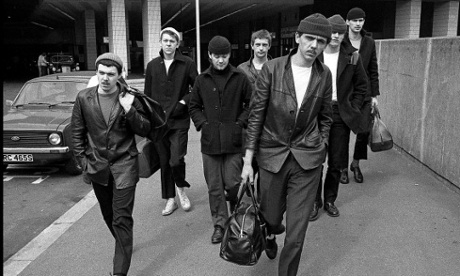‘Absolutely not,” says John Simons when asked if he can remove his cap for a photograph. He insists he’s not being stubborn or difficult, though. It’s just that this would ruin his look. “It’s part of my outfit. I can’t take it off,” he says. By way of compromise, he agrees to tilt his head back a little.
For Simons, even as he prepares to turn 79, items of clothing are not merely about comfort or functionality, but extensions of the wearer’s personality. Everything must be just so, elegant, the result of no little thought. The coat he has chosen to wear while being photographed outside his London shop in the rain underlines his philosophy: that quality lasts, that fashions may change but style is eternal.
This particular vintage Burberry trench – with its soft silk-like lining and distinctive stitching on the sleeves, the evolution of which Simons explains in microscopic detail – is a rare piece, virtually the same as the one he’s wearing in a 1955 photograph that he digs out to show me.
Simons is the subject of A Modernist, a new film that chronicles his rise from Jewish teenager with a passion for fashion in the 1950s to one of UK clothing’s most revered figures, inspiring generations with his succession of pilgrimage-worthy shops. But the film is more than just the tale of one man’s life and work – it’s a celebration of British youth subculture since the mid-1960s.
“I wasn’t surprised someone wanted to make a film,” Simons says, sipping an espresso in the cafe across from his shop in Chiltern Street, Marylebone, a suitably old-fashioned part of London known for independent boutiques and Victorian architecture. “I’ve been cracking away at this for well over 50 years. That’s not meant to sound arrogant, but I have done some unique things. People like to hear about that.”
The documentary – directed by Lee Cogswell and produced by Mark Baxter, the duo behind Peter Blake: Pop Art Life – uses archive footage, evocative imagery and a range of immaculately dressed talking heads, from Paul Weller to Suggs from Madness, DJ Robert Elms to Kevin Rowland of Dexys Midnight Runners.
While it focuses on the essence of Simons’ life and career, the film also brilliantly captures the cultural explosion of the mid-1950s, as the vision of drab prewar UK faded and an undercurrent of colour and creativity burst through. It’s a world of low rents, gentlemen’s agreements and naked optimism – one we are unlikely to see again any time soon.
Simons was born in London in May 1939, four months before the outbreak of the second world war. He moved with his family to Market Harborough in Leicestershire to escape Luftwaffe raids, returning after the war. It was then that Simons’ interest in fashion began to form. His dad was a tailor, skilled in the difficult art of attaching velvet to jacket collars, while his three uncles made women’s suits for C&A. “My uncles were single and they weren’t wealthy, but they had enough money to spoil their little nephew.”
He paints a picture of an impossibly exciting time, with holidays in Brighton and trips to the tailor, the barber, and all the Italian coffee shops popping up in Soho. “There was always someone around selling clothes, silk ties, or this and that. My family were all very well dressed, but I was interested in it all. I’d customise my clothes, experimenting all the time.”
The uncles were friends with Cecil Gee, owner of a three-storey menswear shop in Charing Cross Road on the edge of Soho. Simons completed a full apprenticeship there, quickly becoming an expert window dresser. His windows have been talking points ever since, with designer Paul Smith – an avid customer – describing them as “like theatre”. Simons spent four years in the display team at Burberry and was invited to do the windows at another menswear shop, Austin’s, on Shaftesbury Avenue, as a freelancer.
Austin’s sold almost exclusively American clothing, and it was here that Simons’ enduring love affair with the “Ivy League” look began: a collegiate, neat aesthetic typified by soft-shouldered, single-breasted suit jackets, slimfit trousers, Oxford shirts, penny loafers and a short-back-and-sides. Think JFK, or weekend Don Draper in polo shirt and chinos.
At Austin’s, there was no curation as such, and the shop was not a youth hangout. It was an old-fashioned retailer selling to middle-aged businessmen looking for a hint of Madison Avenue. En masse, the conservative-looking clothes could seem bland, but by picking out select lines and adding a distinctly British twist, it was possible to mould an entirely new look. Simons had found his niche.
“When you were born like I was, just as the war started, the big draw growing up was the US – for music, art and imagination. It was a magical and distant place with incredible style. The films, the TV … but it was the music that was especially big for me.” Rolled up with all this was a burgeoning love of jazz. He started having saxophone lessons – he still plays – and studied the look of his heroes on Blue Note record sleeves, still a source of inspiration.
“We started selling a green button-down shirt like the one Miles Davis wore on the cover of Milestones,” he says. It is still selling well. Martin Freeman, a loyal customer and one of the backers of A Modernist, was recently spotted wearing one while promoting his new film Ghost Stories.
By his late teens, Simons was ready to branch out. First, there was Clothesville, a makeshift shop in the foyer of a clothing factory beside the Hackney Empire in east London. There were Oxford shirts, slim-legged trousers, tapered peacoats and Clothesville’s twist on a Burberry shooting jacket, in varying shades of corduroy. They expanded to nearby Walthamstow market, but their key supplier didn’t want to take things any further, certainly not as far as Richmond, where Simons had set his sights.
And so, with new suppliers and a little help from a friend to cover the £14-a-week lease, The Ivy Shop in Richmond was born. “We opened on a Saturday in the summer of 1964,” says Simons. “We took £60 on the first day, which was a lot of money. It made me think we’d be OK.” The shop’s success grew, although it was a couple of years before it became a destination; if not actually spawning a handful of mod movements, then certainly dictating the uniform.
“It was people who wanted to dress like Jack Lemmon in The Apartment that we really wanted to attract, but that never happened. All the Jack the lads came instead. I guess the suedehead thing was what we most inspired.” Prominent at the tail end of the 60s, suedeheads were subtly different from the earlier skinheads. Taking more of a steer from Jamaican culture, their soundtrack was ska and rocksteady, and they were very smartly dressed in blazers, button-down shirts, club-stripe ties, brogues and bright socks.
“I remember driving past the shop with my mum and dad when we were on our way up to Richmond,” says Paul Weller, another of the film’s backers. “I was really, really gutted that I couldn’t stop to have a look in there. Those suedehead fashions, a crombie with Sta-Prest trousers, wing-tipped brogues – beautiful really. It was very formal, almost like a New York banker or something, but you’d see all these little herberts wearing it, appropriating it and looking great. That’s something British youth, up to a point, always did really well.”
It was at The Ivy Shop that Simons christened the Harrington jacket. The Baracuta G9 – a smart golf jacket with elasticated waist and cuffs and a Fraser tartan lining – was often worn by Rodney Harrington, a character played by Ryan O’Neal in US drama Peyton Place. When Simons was displaying one of the sought-after garments in his window, he would add a handwritten note saying: “The Rodney Harrington jacket”, later shortening it to “Harrington”. It stuck and the name has now been adopted by manufacturers the world over.
Simons started another trend while in Richmond. Still fascinated by east-coast jazz and the New York School art scene, he travelled to the Big Apple to meet manufacturers. He managed to negotiate bargain prices on end-of-season lines to bring back to the UK. “Of course, their last season wasn’t our last season,” he says. “I went to the Empire State Building and bought all these madras shirts for a dollar a dozen. People were jumping up and down for them in London.”
In 1981, building on the success of The Ivy Shop and subsequent premises on Soho’s Brewer Street (The Squire Shop) and Chelsea (The Village Gate), Simons opened J Simons in Covent Garden. It was here that Jason Jules, the film’s writer and an impossibly well-dressed stylist, first became a customer. “I remember seeing all these shoes – Florsheims, Walkovers, Sebagos,” Jules says. “The quality of these things I’d only ever seen in films. This was pre-internet, so I didn’t really know these things actually existed.”
Jules came up with the idea for A Modernist a couple of years ago, after being mistakenly informed Simons had died. Once the error had been cleared up, he was moved to honour the life and work of a man he sees as a great unsung hero in British fashion. Kevin Rowland, meanwhile, regards Simons as a great artist, worthy of a statue, while Weller admires his unwavering commitment. “He’s not pandering to anyone,” he says. “It’s basically: if you don’t like it, then don’t fucking come. And I like that.”
• John Simons: A Modernist is out now.











